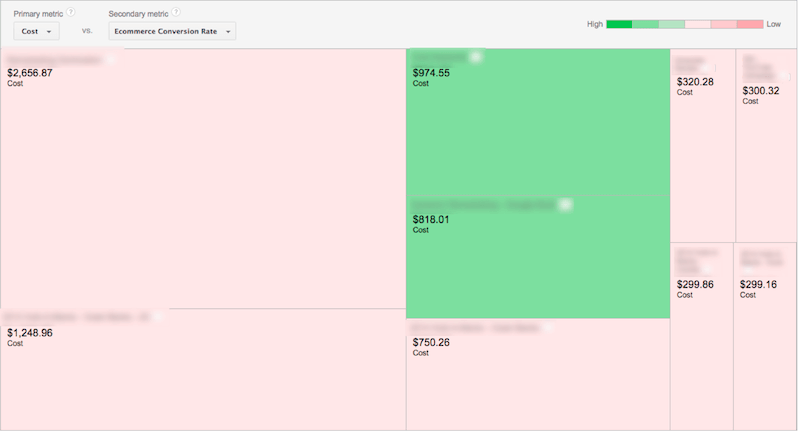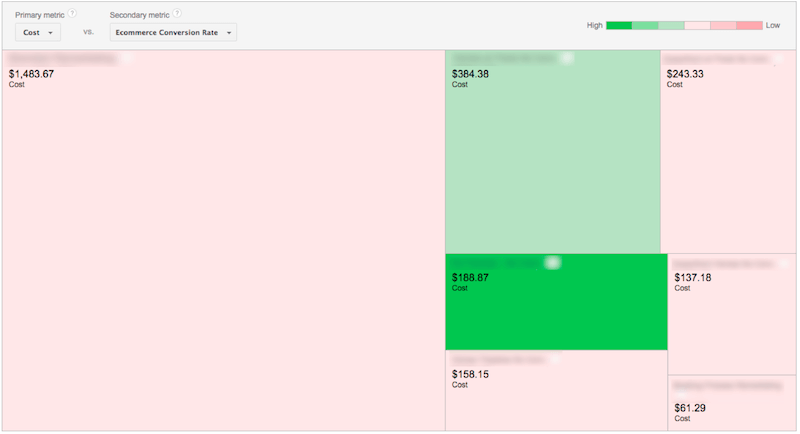Using The New Treemaps Report In Google Analytics To Find AdWords Nirvana
Google Analytics' new Treemaps report allows for lightning-fast analysis. Contributor Matt Lawson goes through some analyses to use in your account.
AdWords is better when it’s linked with Google Analytics (GA). Analytics reporting gives you much deeper insight into your AdWords performance.
Instead of focusing on the wide array of awesome reports that are available in GA, I want to spend today focusing on a new report that was just released and that will be rolling out over the next few weeks to all GA accounts. Treemaps. (Disclosure: I work for Google.)
Getting To Know Treemaps
Treemapping, in the ever-updating words of Wikipedia, is “a method for displaying hierarchical data by using nested rectangles.”
Nested rectangles, you guys. NESTED RECTANGLES! (I think it’s a sign that I’ve found the right career path when the previous sentence gets me excited.)
In case you don’t share my immediate enthusiasm for nested rectangles, here’s why you should care about Treemaps: you can identify trends and trouble spots across your account with speed and insight that you don’t have when looking at numbers alone.
Treemaps also serve as an awesome hypothesis-generation tool — spend ten minutes in this report, and you can understand your account like never before. What are the relative levels of importance of different areas of your account? Are there things that you care too much about, or things that you’ve overlooked?
Before we dive in, just a couple of things that you should be aware of when working with Treemaps:
- The surface area of your rectangles represents the volume of whatever primary metric you select
- The green-to-red overlay represents whichever secondary metric you select in your account
- As stoplights have taught us, green is good and red is bad. Thus, for metrics where a high number is good (like click-through rate) you’ll see higher numbers in green; for metrics where a high number is bad (like bounce rate) you’ll see higher numbers in red.
- If you have multiple accounts linked to your Google Analytics account, Treemaps will default to showing accounts. If you just have one account linked, then the default will be campaigns.
- You can drill down by clicking on your accounts/campaigns in the report (and then get back to a higher view with a breadcrumb trail above the report)
Without further ado, let’s get to some specific reports that you should run to get to know (and love) the nested-rectangley goodness of Treemaps.
1. Cost Vs. E-Commerce Conversion Rate
It’s immediately apparent where your conversion rates are higher in those green boxes.
What can you do to increase volume in those areas? And what can you learn from the green boxes to apply elsewhere in your account?
After we click on the biggest campaign in the first chart we can see that not every ad group is suffering a low conversion rate.
There’s a clear ad group that’s worth focusing on — your highest spending ad group in your highest spending campaign suffers from below-average conversion rates.
What different creatives or landing pages should you experiment with to increase performance?
2. Impressions Vs. Click-Through Rate
Ad testing is a bit of a bear; so, focusing your efforts when improving ads is key.
The red and green designation can get tricky across networks, so beware of how this report will look when you have display and search in the same account.
But, your attention should be immediately focused on what’s working and what isn’t. Click into the smaller search ad groups (which typically have fewer impressions) and see what you can learn.
Those green ad groups probably have something to teach to the red ad groups (as long as they’re in the same network, of course).
And as a side note, you can hover over the speech bubble on each rectangle to see more specific details. That way, you have the numbers that are dictating the size and shade of that rectangle.
3. New Users Vs. Bounce Rate
Which keywords drive new users, and which of those aren’t doing a very good job of turning those users into customers?
Even if things are looking pretty good (like in the screenshot above), you can show this report to the powers-that-be to let them know that the majority of new site visitors in this campaign have a better bounce rate when compared to your smaller ad groups.
You don’t always have to have an action item from one of these reports; sometimes it can be a pat-on-the-back generator.
Making Treemaps Your Own
So, those are just three analyses, but there are so many more that are worth running. I imagine you get the idea by now, so go out there and find your own insightful combinations.
Here’s what’s currently available for you to look at in your own Treemaps. Mix and match them to find some analyses that can give you great insight along with ideas that you can start testing.
Primary Metric
- Clicks
- Clicks
- Cost
- Impressions
- E-commerce
- Revenue
- Transactions
- Site Usage
- Goal Completions
- Summary
- Goal Value
- New Users
Secondary Metric
- Clicks
- CPC (Cost-per-click)
- CTR (Click-through-rate)
- ROAS (Return-on-ad-spend)
- RPC (Revenue-per-click)
- E-commerce
- Average Order Value
- E-commerce Conversion Rate
- Per Session Value
- Site Usage
- % New Sessions
- Avg. Session Duration
- Bounce Rate
- Pages/Session
- Summary
- Goal Conversion Rate
Conclusion
We’ve spent a relatively small amount of time putting these analyses together, and we already see so many areas that would be worth looking into.
Treemaps just takes the data that’s already available to you, and you can use it to tell a story rapid-fire. It’s like skipping to the good parts of account analysis.
Start using Treemaps to find the questions that are truly worth asking about your account.
Contributing authors are invited to create content for Search Engine Land and are chosen for their expertise and contribution to the search community. Our contributors work under the oversight of the editorial staff and contributions are checked for quality and relevance to our readers. The opinions they express are their own.
Related stories
New on Search Engine Land






